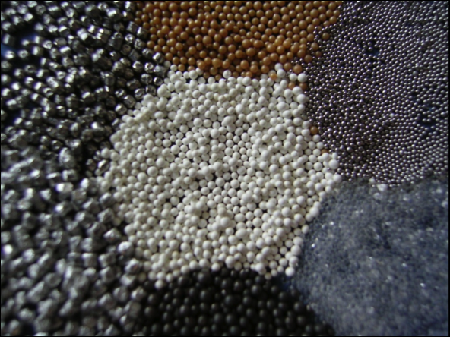Related Resources: manufacturing
Shot Peening Media Review
Stainless steel media is used in applications where iron contamination is a concern. Carbon steel cut wire, conditioned into near round shapes, is being specified more frequently due to its uniform, wrought consistency and great durability. It is available in various grades of hardness and in much tighter size ranges than cast steel shot. Glass beads are also used where iron contamination is of concern. They are generally smaller and lighter than other media and can be used to peen into sharp radii of threads and delicate parts where very low intensities are required.

Cast steel shot is created by atomizing molten steel, then heat treating and sieving the resulting material.
Advantages:
- More durable (longer life) than glass and ceramic shot
- Available in carbon steel and stainless steel
- Ability to achieve the highest intensity
- Easiest to maintain spherical particles
Disadvantages:
- More difficult than cut wire shot to maintain spherical particles
- Less durable than cut wire shot
-
High material cost
Cut wire shot is created by cutting drawn steel wire to lengths approximately the same size as the width of the wire. The resulting wire is then rounded to remove the sharp edges.
Advantages:
- Produces uniform results due to its consistency in size, shape, and hardness
- Tends to wear down into smaller diameter rather than fracture into particles with sharp edges
- More durable (longer life) than cast steel, glass, and ceramic shot
- Available in carbon steel and stainless steel
- Ability to achieve the highest intensity
- Easiest to maintain spherical particles
Disadvantages:
- High material cost
- Limited sizes
Glass shot is created by atomizing molten soda lime, then sieving the resulting material.
Advantages:
- Available in wide range of sizes
- Low cost material
- Inert material, will not cause ferrous contamination or leave residue on work piece
- Environmentally friendly
Disadvantages:
- More difficult than steel media to maintain spherical particles
- Less durable than steel and ceramic media